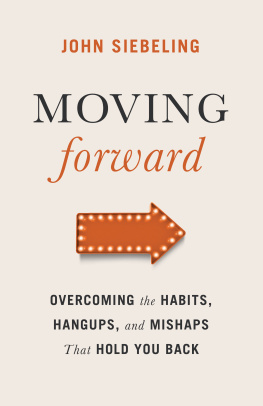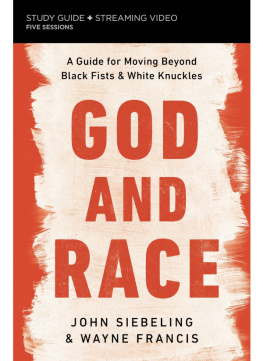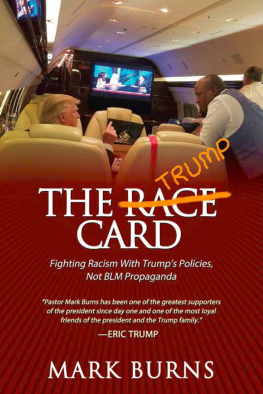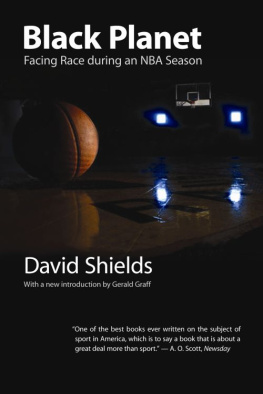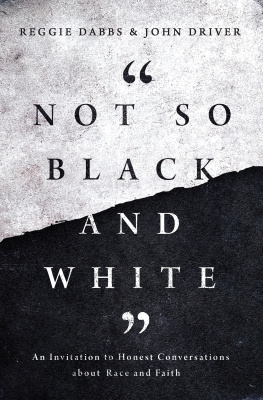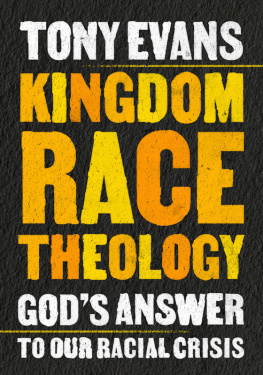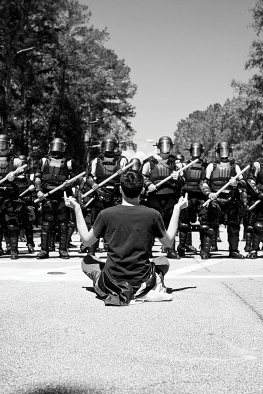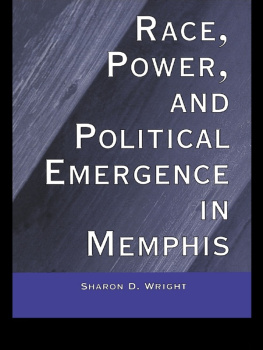Contents
Guide
Contents
BEGIN CREATING A HOUSE THAT LOOKS LIKE HEAVEN
JOHN SIEBELING AND WAYNE FRANCIS
You have a problem.
Its a complicated problem with historical, political, and spiritual dimensionsand its a big deal. We have the same problem, and so does everyone else in the world.
Racism is real, and it affects everyone.
The thing about complicated problems is there are no simple solutions. Approaching racial tension with simple solutions is like a heart surgeon stepping into surgery armed with a couple of Band-Aids and a Get Well Soon card.
One book is not going to fix centuries of pain, profiling, and privilege. However, although there are no simple solutions to this complex problem, we believe there is a simple starting point. If our country is going to start to heal from centuries of tension, its going to be because we begin having civil conversations with people who dont look like us.
Conversations are the starting point because so much of the misunderstanding comes from a lack of perspective. The next time you are in the same room with someone, try this exercise. Hold this book up between you with the front cover facing you and ask them to describe what they see. Even though they are looking at the same book as you, they will describe the back cover. You are looking at the same object but from two different vantage points.
For the sake of the illustration, pretend you want to know what the back cover looks like but arent able to turn the book around. What would you do? You wouldnt make something up in your head and assume you already know what it looks like. The way forward is to ask the right questions to the person who can see it and then listen to their perspective. You may not be able to see the back cover, but you can engage in a conversation with that person and let them paint a picture of it for you. Together, you can each gain a better understanding of the whole book.
That is a simple illustration with powerful implications. The truth is, no matter who you are, you have a limited vantage point. Thats not a shot at you; its an observation about humans. You are seeing every problem our world is facing from your perspective. Which is why so many racist remarks begin with
Why cant they just...
I dont understand why he doesnt...
If it were me, Id already have...
But when we learn to have actual, mature conversations with people of other ethnicities, our perspectives and horizons are expanded. In this book, we want to give you a guide for not just starting conversations with people who dont look like you, but letting those conversations turn into friendships.
The starting point is simple, but that doesnt mean starting is simple. Learning how to have conversations about race is an art, and that art is what this book is all about. These conversations can be intimidating, but well be your guides and help you navigate the waters of race relations with confidence and grace.
Why are conversations about race (particularly in the White-Black tension) so scary to initiate and difficult to sustain? (By the way, we know racism is not solely a Black and White problem, but that is our context. Whatever ethnicity you are, whatever hardships youve experienced, we hope that by hearing about racism from our two perspectives, youll be able to step into your arena and fight your fight with confidence and love.)
The Black and White tension is tense because we are inheriting centuries of pain and power struggles. Conversations work best when done with open hearts, open minds, and open hands. But hundreds of years into this struggle, its not always easy to enter the conversation with open hands. The reason conversations can be so difficult and intimidating is because instead of coming to the discussion with open hands, weve brought Black fists and White knuckles.
Black Fists
WAYNE FRANCIS
I grew up with a lot more hair than I have today. Like many young Black men, I never left the house without my hair pick. If you dont know what a hair pick is, google it. We carried them around everywhere because you never knew when you might need it.
The handle at the end of my pick was a Black fist, a symbol that was made famous at the 1968 Summer Olympics, when Tommie Smith and John Carlos, two African American athletes, raised their fists during the medal ceremony. As the Star-Spangled Banner played, they put their fists in the air to stand in solidarity for the Black community. Ever since, the Black fist has become a symbol of standing up against the residue of segregation, slavery, and the systematic oppression that was (and still is) happening against Black people in our country.
I rocked my pick with pride. To me, the Black fist was a cool symbol of style and culture and was a beautiful sign of strength. The Black fist is retaliatory in its nature, and when you feel oppressed, fighting seems necessary.
Historically, the Black community has been oppressed. When being oppressed, the solution is not to give up or give in. Conforming or muting our Blackness is not the answer. The way forward is to be who we are. This isnt a book about ignoring centuries of oppression. This isnt a book about getting amnesia. Quite the opposite: if we want to get to where we want to be, we have to remember where we came from.
The question is, however, How do we move forward? Ive heard it said that racism is prejudice plus power, whether you are trying to obtain it or maintain it. For the Black community, our journey has been an attempt to obtain power. From here, whats going to help moreopen hands or clenched fists?
There is a time and a place for making a scene, but real power comes when we open our hands. We can have open-handed conversations without compromising our integrity. Thats what Ive learned from my friendship with John.
The first time I met John, I was on the heels of preaching a seven-minute sermon at the ARC Conference, an annual church planting conference. ARC (Association of Related Churches) has helped plant hundreds of churches all around the world, and its conference is always a highlight of my year. John walked up and introduced himself, but to be honest, I knew exactly who he was. Hes on the leadership team of ARC, so hes kind of a big deal in the church planting world. Plus, Id heard all about the success he had building a diverse church in Memphis.
At the time, I had been leading a church in New York for many years, aspiring to build a church like his, and though we were successful, it was a slow burn. I had mega-church dreams but was experiencing a bunch of mini-church nightmares!
John and his wife, Leslie, gave me a bunch of compliments about my sermonette and how they had a great time listening to me speak. I told them that I had heard about them for a while, and I wanted to check out their church. Thats common small talk in the church world, but nothing conclusive hardly ever comes from it.
But John was different.
A few weeks later, I was on a plane to Memphis. We had a blast. The connection was easy and natural, and before I knew it, I was flying to Memphis every month. The Life Church quickly became my favorite church to be a guest speaker atthey made me feel right at home.
Behind the scenes, John and I were forming a true friendship. Honestly, it was the monthly BBQ fixes we bonded over, but I loved making him crack up with random jokes and impressions of Jamaican characters from my upbringing. And I loved how transparent I could be with him. Our conversations went so deep at times that I almost started packing scuba gear before my visits!


